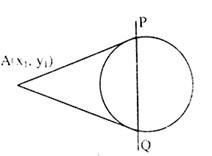Ice cream on the side
 For a circle
x
2
+
y
2
=
r
2
,find the value of r for which the area enclosed by the tangents drawn from the point
P
(
6
,
8
)
to the circle and the chord of contact is maximum.
For a circle
x
2
+
y
2
=
r
2
,find the value of r for which the area enclosed by the tangents drawn from the point
P
(
6
,
8
)
to the circle and the chord of contact is maximum.
The answer is 5.
This section requires Javascript.
You are seeing this because something didn't load right. We suggest you, (a) try
refreshing the page, (b) enabling javascript if it is disabled on your browser and,
finally, (c)
loading the
non-javascript version of this page
. We're sorry about the hassle.
2 solutions
Here is a random animation about this.
Log in to reply
Hey, great website you've introduced me to !!! Thanks.
I used AM-GM 3 A 2 ( x ) = 3 x ( 1 0 − x ) 3 = 3 x ( 1 0 − x ) ( 1 0 − x ) ( 1 0 − x ) Now Using Conditions of AM-GM inequality x ∈ ( 0 , 1 0 ) 3 x , ( 1 0 − x ) , ( 1 0 − x ) , ( 1 0 − x ) ⟶ A M − G M A M = 4 3 0 = c o n s t a n t 3 x = 1 0 − x ( G M i s m a x t h e n n u m b e r s a r e e q u a l ) ⇒ x = 2 5
The point P ( 6 , 8 ) is a distance of 1 0 from the origin, so it will be the same if we just look at the tangents through the point S ( 1 0 , 0 ) .
The area of the triangle as described will then be A = y ( 1 0 − x ) , where ( x , y ) is the (upper) point of tangency. Now for the circle, the line of tangency to any point ( x , y ) on the circle will have slope − y x . We thus will require that the line joining S and ( x , y ) have the same slope as the tangent line. This will be the case when
1 0 − x − y = − y x ⟹ y 2 = x ( 1 0 − x ) ⟹ y = x ( 1 0 − x ) ,
as we are focusing on the point of tangency in the first quadrant. This gives us an expression for A in terms of one variable, namely
A ( x ) = x ( 1 0 − x ) 2 3 .
Differentiating and setting equal to zero, we have
A ′ ( x ) = 2 x 1 ( 1 0 − x ) 2 3 − 2 3 x 1 0 − x = 2 x 1 0 − x ( 1 0 − 4 x ) = 0 .
Now clearly x = 1 0 , so we are left with 1 0 − 4 x = 0 ⟹ x = 2 5 .
This gives us a value for y of
2 5 − 4 2 5 = 2 5 3 ,
which in turn gives us a value for r of
4 2 5 + 4 2 5 ∗ 3 = 2 5 = 5 .